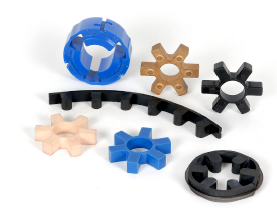Elastomers In Compression
We presents four types of elastomer patterns to permit for further flexibility in addressing specific application needs. A single piece models are used in the “L” and “AL” models (known as spiders) and many portion “load cushions” are used in the “C” and “H” model couplings. The load cushions are in sets of 6 to 14 pieces based upon coupling size.
Strong Center Spider
The sound center style is usually used design when shafts of the driver and driven equipment is often stored separate by a conventional gap
Open Center Spider
The open center design and style lets for that shafts of the driver and driven to be positioned within a short distance
Open center spiders offer you shaft positioning versatility but possess a reduce RPM capacity
Cushions
Used exclusively for that C and H Type couplings
Load cushions are held in location radially by a steel collar that is connected to among the hubs
Snap Wrap Versatile Spider
Layout enables for straightforward elimination from the spider with no moving the hubs
Allows for near shaft separation the many way up to the hubs greatest bore
Maximum RPM is 1,750 RPM using the retaining ring, but if utilised with the LC Sort (with collar) the standard RPM rating in the coupling applies
Design is available in NBR and Urethane only, and in limited sizes
Spider Components
SOX (NBR) Rubber
The normal materials that is highly versatile materials that’s oil resistant
Resembles organic rubber in resilience and elasticity, and operates proficiently in temperature ranges of -40° to 212° F (-40° to 100° C)
Urethane
Has one.five times greater torque capacity than NBR
Great resistance to oil and chemicals
Materials provides less dampening impact and operates at a temperature range of -30° to 160° F
Hytrel
Flexible elastomer created for high torque and high temperature operations
Operates in temperatures of -60° to 250° F (-51° to 121° C)
Bronze
Rigid, porous, oil-impregnated metal insert exclusively for minimal speed (max 250  RPM) applications requiring large torque abilities
RPM) applications requiring large torque abilities
Not affected by water, oil, dirt, or severe temperatures – operates in temperatures of -40° to 450° F (-40° to 232° C)